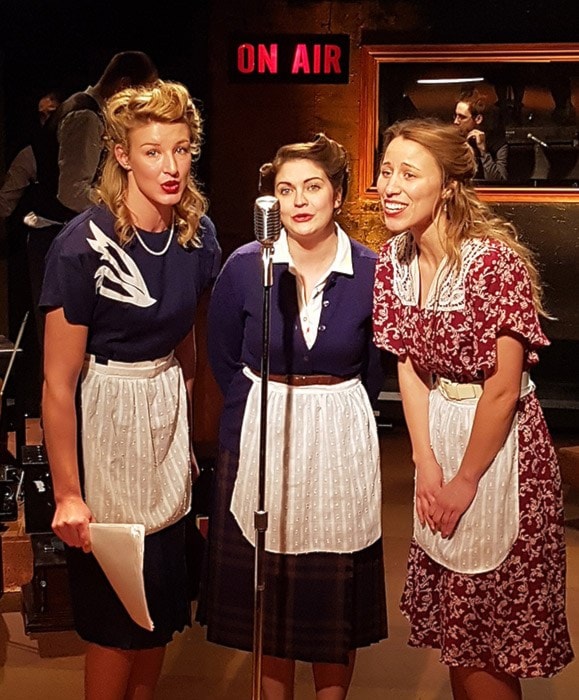Light and sound are critical to any well-produced play. But for most productions, those parts of the show are all done in the shadows.
Audience members don’t get to see how the work gets done — they just sit back and enjoy the final product.
Starting this week, the Guild’s production of It’s a Wonderful Life is pulling back the curtain to give audiences an idea of how sound would have been created for a radio drama more than half a century ago.
Peter Church’s stage script adapts Frank Capra’s 1946 classic Christmas film into a mock radio play, complete with advertising jingles. It’s performed on stage, in front of a live audience.
In a modern radio play, creating the sound of a car whizzing past or a couple walking up a snowy path could be done by downloading a sound effect off the internet and hitting a button.
But that’s not the way this play wants to do things, said director Sarah Rodgers. The idea here is to honour the year the movie was created.
“That’s not how they did it in 1946 and I wanted the audience to really witness how a radio studio was truly working in 1946.”
Enter Joel Stephanson, the show’s musical director. From a platform on the stage, he’s responsible for creating all the music and sound effects for the play.
Does George want to go for a walk in the snow? It’s Stephanson squeezing balloons full of corn starch to make the crunch.
The wind machine is hand-built — as it would have been in the 1940s — and is cranked by hand. A jalopy’s rickety engine comes to life using a metal fan hitting the sides of a metal box. A saw, dropped on the desk, makes the sound of a screen door slamming shut.
“I just love that it’s done with that one object,” Stephanson said. “You don’t have to go and build a whole door. There’s something fun about the elegance of it.”
At one point Stephanson plays Chopin on the keyboard with one of his hands and We Three Kings with the other.
All of this while the audience watches.
“It’s incredible to watch Joel do the foley. He barely has a second. He does not stop from the moment he plays the opening number,” Rodgers said.
“I don’t think he has time to even look at a cheat sheet. He goes from piano, to ringing a bell, to blowing the wind, to banging spoons to playing the piano.”
The show has a 55-minute first half and a 42-minute second half.
Stephanson said he finds the work gratifying.
“There’s something about just checking each task off my list,” he said.
“OK, we’ve done the snow, we’ve done the footsteps and now we’ve got to play some piano and then you’ve got to pull out the saw.”
This is the second time Rodgers and Stephanson have put the play on together. They staged it two years ago in Vancouver. Stephanson also put on a similar adaptation a year earlier in Alberta.
Finding the right objects to mimic all the effects comes down to trial and error, the pair said.
Some of the objects, like the wind machine, came from Vancouver. Others, like the toy frog that can be made to sound like a cricket if it’s handled just right, came from the cast.
Local volunteers Donald Watt and Al Loewen built an authentic snow machine out of a wooden sieve, a trap door and a rope.
Stephanson won’t be the only busy one on stage. Some of the nine local cast members have as many as six different roles to play.
“What’s fun for the audience is that they get to see this come to life. They actually get to see our actress Krisandra (Reid) transform from Cousin Tilley to Ma Bailey, to a lead in a jingle,” Rodger said.
Even the show’s stage managers get in on the act. Unlike many stages where the stage manager sits at the back of the theatre and has the same perspective as the audience, the Guild theatre has its lighting booth behind the stage.
Normally the booth is closed off. The stage manager works the lights watching the play on a screen. For this play, the booth is exposed to the audience and the staff working the lights are in full period costume.
Along with the sound, it’s all about creating the feeling of that 1940s radio booth, Rodgers said.
“That evokes the atmosphere and lets our imagination see it all.”
It’s a Wonderful Life runs Wednesday to Sunday from Nov. 24 to Dec. 10.
Shows start at 8 p.m. and tickets are $25.
The matinee performance is Sat. Dec. 10 at 2 p.m.
On Dec. 7, the Guild is teaming up with the local Letter Writing Club for a special event. Doors open at 6:30 p.m. and audience members can spend the time before the show writing Christmas letters on typewriters, or enjoying a hot beverage like a George Bailey and coffee.
For more information, visit the Guild’s website at www.guildhall.ca.
Contact Ashley Joannou at ashleyj@yukon-news.com
